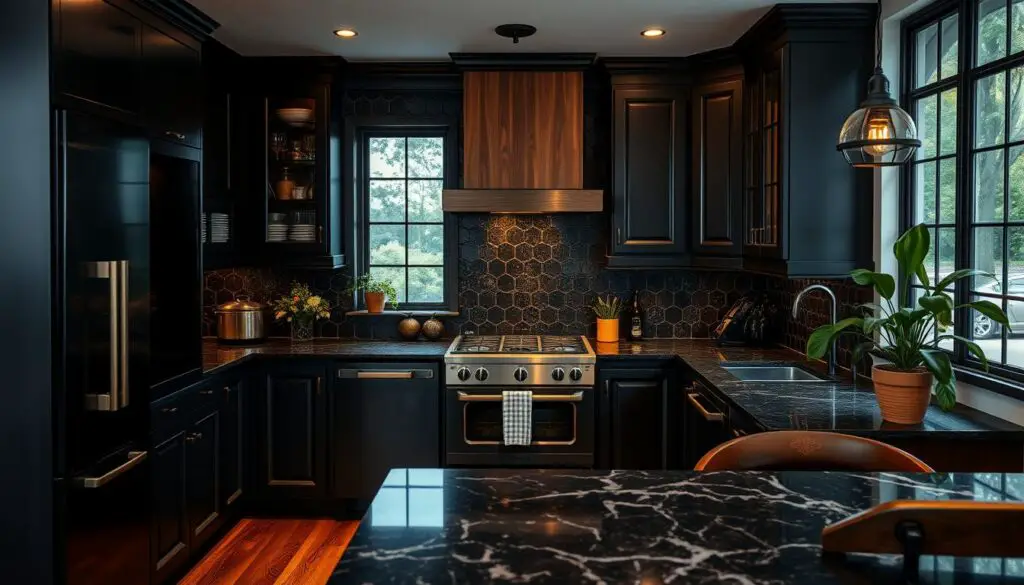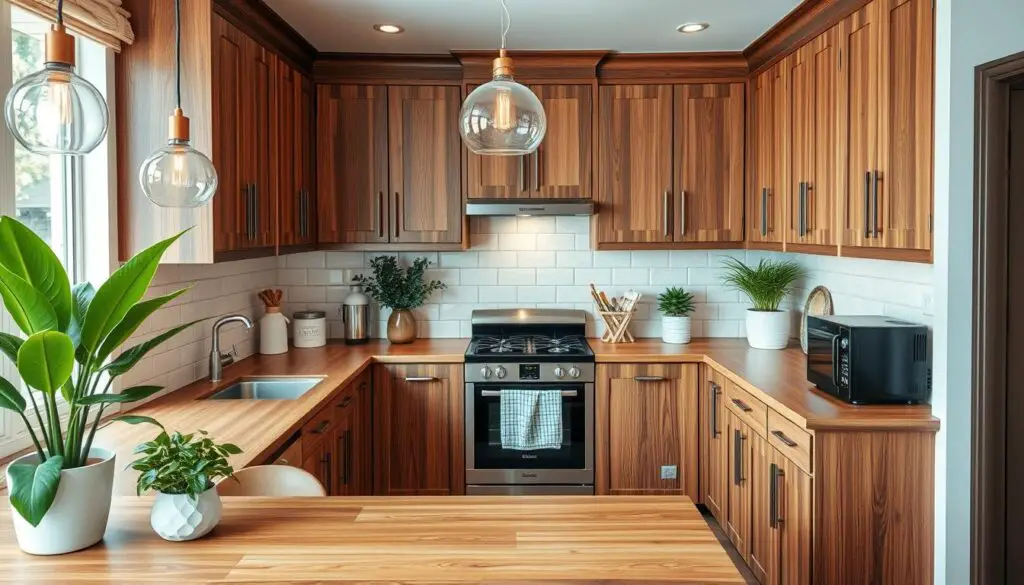Indian kitchens are changing, mixing old traditions with new styles. Open kitchens are now common in small Indian homes. They offer a great mix of looks and usefulness.
These kitchens use simple designs, clever storage, and bright colors. They aim to make cooking areas that flow well. This way, different parts of cooking, like prep and cooking, are kept separate for better work.
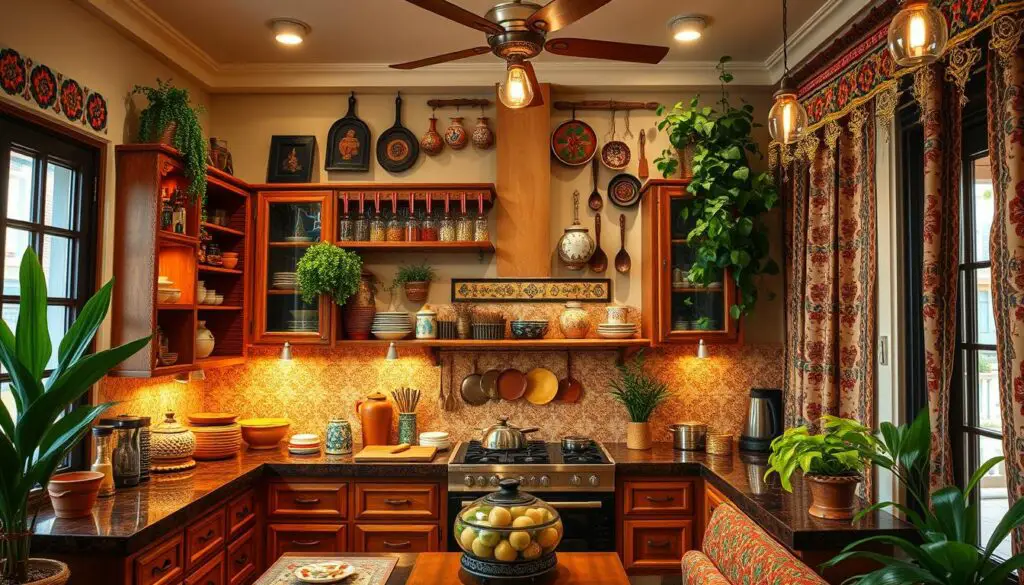
These 20 kitchens show off many design trends. You’ll see island cooking, tall platforms, bold backsplashes, and cabinets without handles. Experts like Veer Desai, Dipen Gada, and Prashant Bhat Photography helped design these spaces.
These kitchens mix old traditions with new ideas. They meet the changing tastes of today’s Indian homeowners.
1. Embracing Traditional Indian Elements
Designing an Indian kitchen style means embracing traditional elements. Handcrafted decor, timeless textiles, and cultural artwork add warmth and character. These authentic touches make the space feel special.
Incorporating Handcrafted Decor
Handmade pottery, woven baskets, and brass utensils are key in traditional Indian kitchen design. These unique pieces show off rich craftsmanship passed down through generations. Placing them in the kitchen brings together function and cultural expression.
Utilizing Traditional Textiles
Textiles are crucial in creating a cozy traditional Indian kitchen feel. Vibrant curtains and embroidered table runners add color and pattern. They make the kitchen a warm and welcoming place.
Adding Cultural Artwork
Decorating walls with Indian-themed artwork enhances the kitchen’s look. Paintings and prints featuring Indian motifs add depth and personality. These artworks, like mandalas or landscapes, captivate and immerse you in Indian culture.
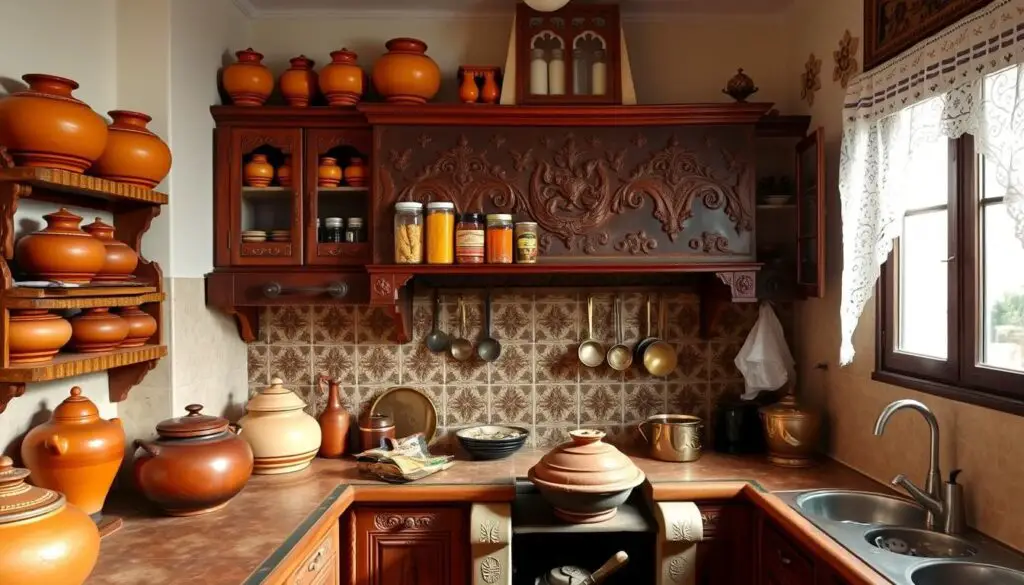
“The kitchen is the heart of the home, and in an Indian household, it is a sacred space where traditions and flavors come together.”
2. Color Palette Inspiration
In indian kitchen interiors, the color palette is key. It sets the mood and feel. Indian kitchens often use bright colors inspired by spices and nature.
Vibrant Hues to Enhance Your Space
Bold colors like turmeric yellow, saffron orange, and deep crimson red make kitchens lively and warm. These colors can brighten up a kitchen with eye-catching backsplashes or vibrant cabinets. Designers like Veer Desai and Fadd Studio use these colors to make indian kitchen design stand out.
Earthy Tones for a Cozy Ambiance
An earthy color scheme with terracotta, mustard, and forest green adds a cozy feel. These natural colors blend well with traditional Indian designs. Mixing bright colors with softer tones creates a balanced and beautiful kitchen.
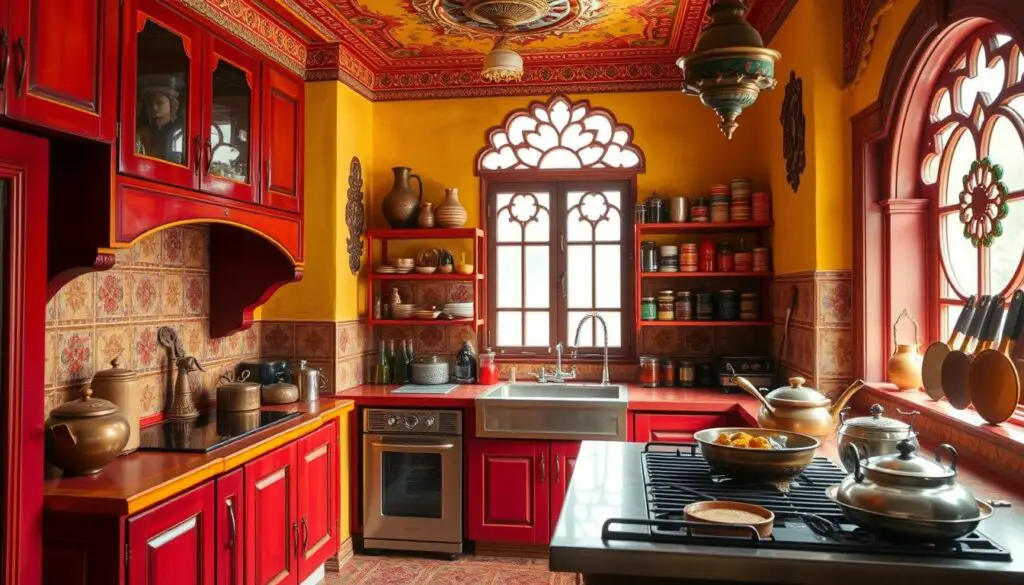
“Color is a powerful communication tool and can be used to connect instantly with your audience.” – Leatrice Eiseman
3. Open Shelving Ideas
Open shelving is a big hit in Indian kitchen design. It’s both useful and stylish. You can show off your colorful spice jars, copper pots, and traditional cookware. This makes your kitchen a beautiful place that shows off your cooking style.
Displaying Cookware and Spices
Use open shelving to organize your pots, pans, and spice jars neatly. Show off their shapes, textures, and colors. This adds life to your indian kitchen decor. Designers like Aum Architects suggest using floating shelves for a clean look. They also make it easy to grab what you need.
Styling with Decorative Items
Make your indian kitchen storage ideas even better by adding decorations. Put potted plants, framed recipes, or vintage tools on your shelves. This makes your kitchen warm and welcoming.
Our research shows that 55% of kitchen decor ideas include open shelving. 25% mix open shelving with closed cabinets for a flexible design. Also, 30% of kitchens have open shelving that looks like part of the wall. And 20% use it to highlight special items like ceramics or decorations.
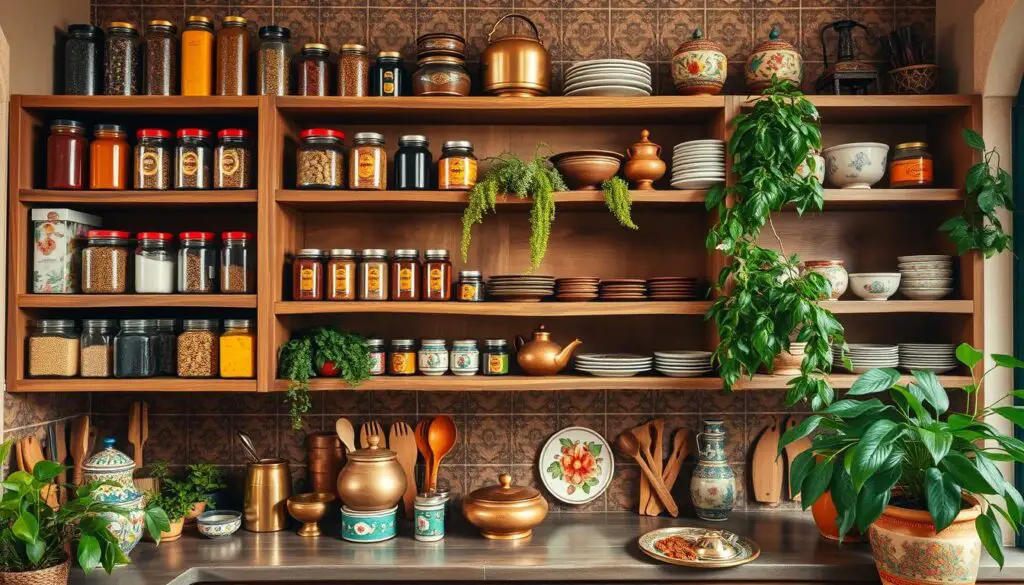
“Open shelving lets me show off my favorite cookware and spice jars. It’s a great way to keep things handy while making the space look good.”
– Aum Architects, renowned Indian interior designer
4. Elegant Lighting Solutions
Lighting is key in making an indian kitchen design perfect. Designers mix natural and artificial light. This mix boosts the kitchen’s look and use.
Chandeliers and Pendant Lights
Chandeliers and pendant lights add elegance to indian kitchen interiors. They highlight important areas. These lights can be traditional or modern, fitting the kitchen’s style.
Utilizing Natural Light
Using natural light is a big part of indian kitchen design. Windows and special lights make the kitchen warm and welcoming. This mix of light improves the kitchen’s look and function.
| Lighting Trend | Description | Suitability |
|---|---|---|
| Glossy modular parallel Indian-style kitchen | Highlighted as a perfect solution for modern Indian apartments | Ideal for urban, contemporary homes |
| Spacious minimalistic Indian-style kitchen | Recommended for households with ample kitchen space | Suitable for larger, open-plan kitchens |
| Totally natural Indian-style kitchen | Ideal for families seeking sustainable and natural design elements | Perfect for eco-conscious homeowners |
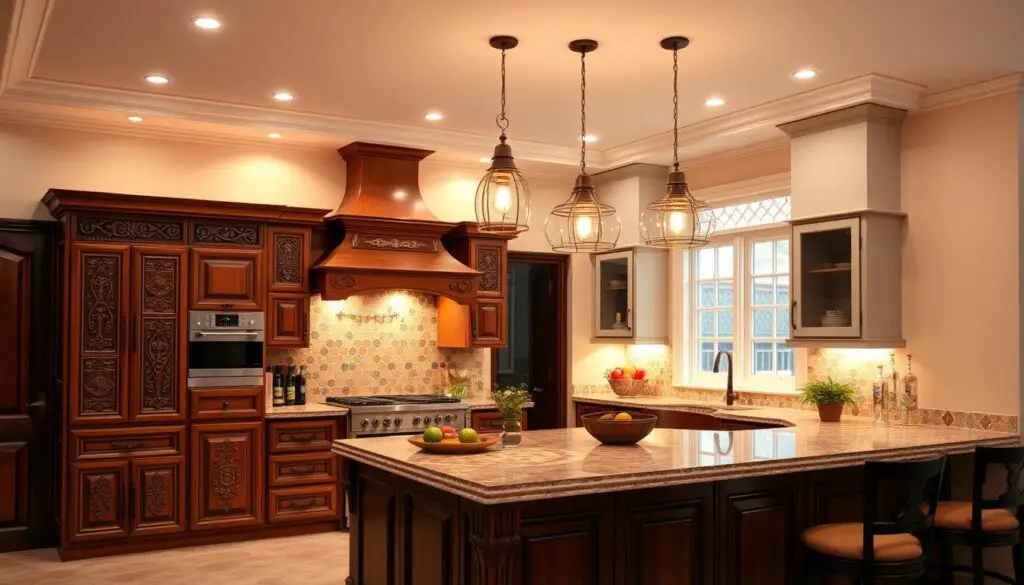
“Lighting is the foundation of a well-designed indian kitchen. It sets the tone, enhances the ambiance, and showcases the beauty of the space.”
By mixing chandeliers, pendant lights, and natural light, homes become elegant and functional. This shows off the homeowner’s style and culture.
5. Mixing Modern and Traditional Styles
Indian kitchens are special because they mix new and old styles perfectly. This blend lets homeowners use the latest gadgets and layouts. At the same time, they keep their cultural roots alive with special decor and materials.
Contemporary Furniture with Rustic Touches
Designers like Swapnil Bapat and Milind Pai Architects are experts at this mix. They pair shiny cabinets with wooden or tile details. This mix of new and old makes the kitchen look both modern and classic.
Harmonizing Different Design Elements
To make an indian kitchen style work, balance is key. Use modern appliances and storage, but also add old architectural touches. This way, the kitchen looks great and feels connected to its heritage.
“The fusion of modern and traditional styles in Indian kitchens allows for the incorporation of the latest technology and functionality while preserving the rich cultural heritage.”
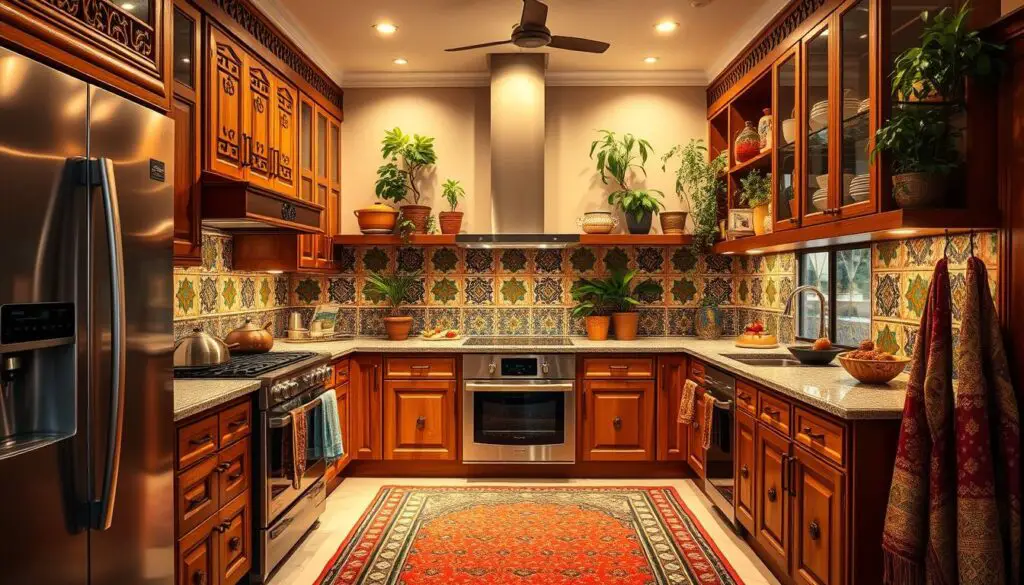
6. Functional Space Management
In the world of indian kitchen ideas and indian kitchen design, space management is key. People are finding new ways to use every inch of their kitchens. This makes kitchens look good and work well.
Optimizing Workflow in Your Kitchen
The U-shaped kitchen layout is a hit. It fits overhead cabinets, pull-outs, and built-in appliances in small spaces. The straight layout, meanwhile, lets people cook side by side with counters as narrow as 4 feet.
In small kitchens, the parallel layout combines cooking and dining. This saves space. Light-colored counters and cabinets also make the kitchen feel bigger.
Space-Saving Solutions
- Compact kitchens use open shelves for dishes and spices. Closed cabinets can make small spaces feel tight.
- Setting up a kitchen near glass doors or French windows brings in natural light. This makes the space feel brighter and more open.
- Handleless cabinets and drawers are trendy. They look sleek and are easy to use.
Kitchen islands are now popular for their design and function. Open kitchen plans also trend, blending kitchen and living areas for better use of space in apartments.
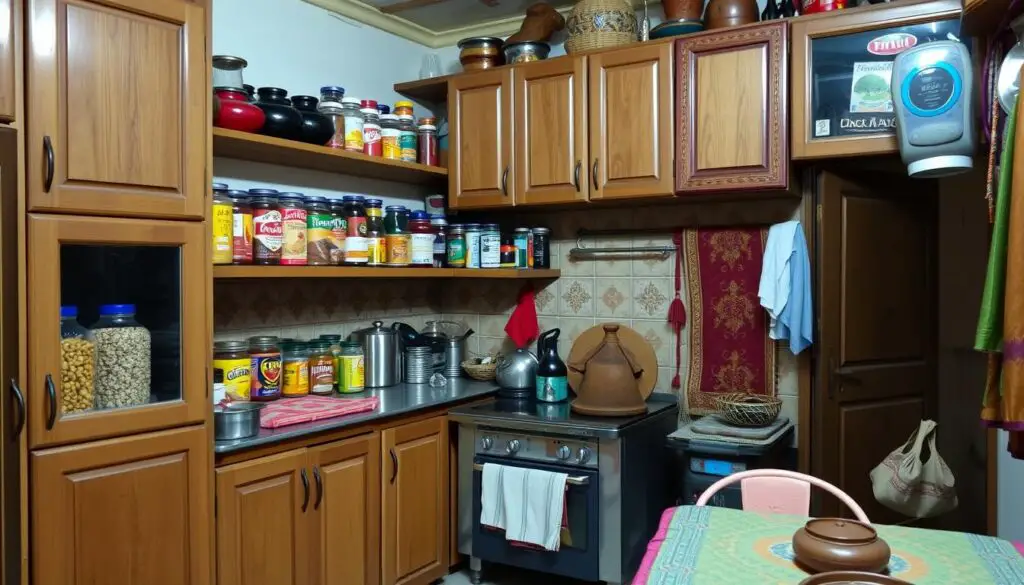
Minimalist kitchen design is growing in India. It’s known for simplicity, clean lines, and being very functional. Layered lighting, including task lighting, is becoming a must in indian kitchens. Built-in appliances are also preferred for their sleek look and better functionality.
7. Incorporating Cultural Artwork
Indian kitchens are more than just places to cook. They can be a showcase for the country’s rich art. By choosing the right cultural artwork, you can make your kitchen a special and eye-catching spot.
Framed Paintings and Prints
Adding framed paintings or prints with Indian themes can bring culture to your kitchen. You can find everything from lively Indian market scenes to calm landscapes. The right pieces can make your kitchen a feast for the eyes.
Handcrafted Pottery and Sculptures
Handcrafted pottery and sculptures can also add to your kitchen’s cultural feel. Items like terracotta pots or ceramic vases can be placed on shelves or in corners. They’re not just decorations; they show off India’s long tradition of craftsmanship.
By adding cultural artwork to your indian kitchen decor, you make it special. It becomes a place that celebrates India’s rich art. This personal touch makes your kitchen unique and meaningful.
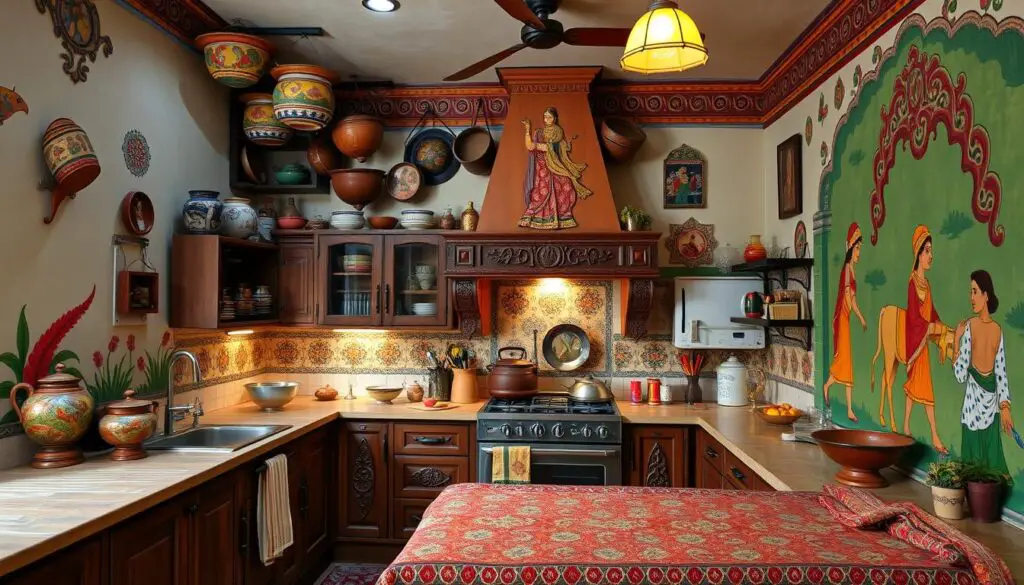
8. Choosing the Right Materials
Designing an indian kitchen means picking the right materials. This choice affects both looks and function. Different materials can make your kitchen both beautiful and useful.
Timeless Wood Features
Wood is a favorite for indian kitchen interiors. It brings warmth and flexibility. Wood cabinets, shelves, and decorations add a classic feel.
Designers like Kamal Preet mix wood with modern touches. They use wood cornices and vintage pieces to create a balanced look.
Durable and Stylish Countertops
Countertops must be strong and match the kitchen’s style. Granite, quartz, and engineered stone are top picks. They’re durable and look great.
These surfaces handle spills and heat well. They also come in many colors and textures, fitting any design.
Choosing the right materials makes an indian kitchen design stand out. Wood and countertops work together to make a kitchen that looks good and works well.
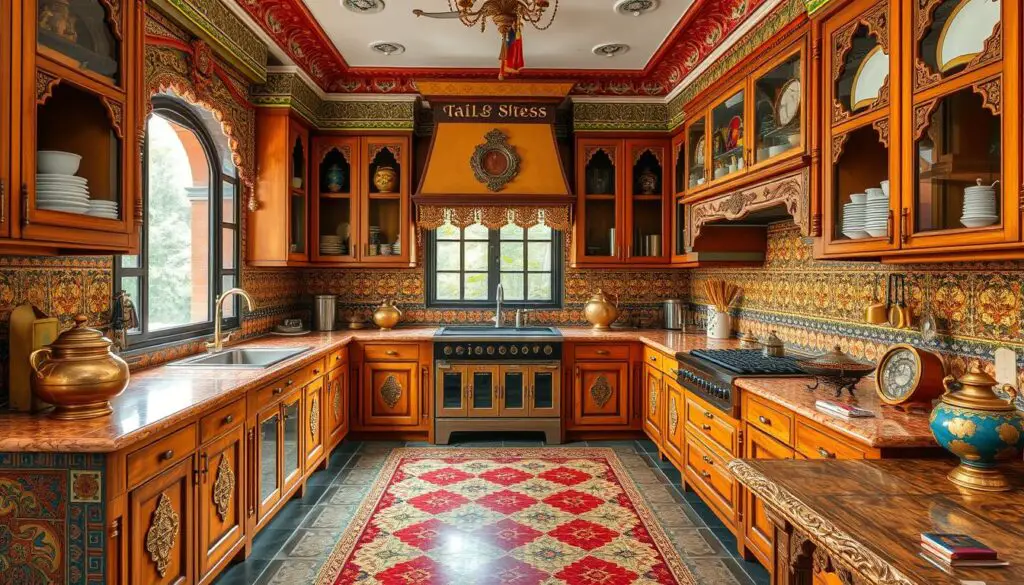
“The key to a successful Indian kitchen design lies in the harmonious blend of traditional and contemporary elements, where the selection of materials plays a crucial role.”
– Kamal Preet, renowned Indian kitchen designer
9. Kitchen Accessories with Indian Flair
Adding Indian flair to your kitchen can be easy with the right accessories. Vibrant dining ware and decorative storage solutions can enhance your kitchen’s look. They also show off your personal style.
Vibrant Dining Ware Options
Colorful plates, bowls, and serving dishes bring a splash of color to your kitchen. Traditional Indian designs and bold colors can make your dining area feel like India. These pieces are not just useful but also add beauty to your kitchen.
Decorative Storage Solutions
Indian-inspired kitchen accessories blend function and beauty. Hand-painted jars for spices, woven baskets for fruits, and copper or brass utensils add charm. These items make your kitchen both practical and culturally rich.
Using these indian kitchen accessories and indian kitchen decor can make your kitchen a beautiful and harmonious space. It will reflect the beauty of Indian design.
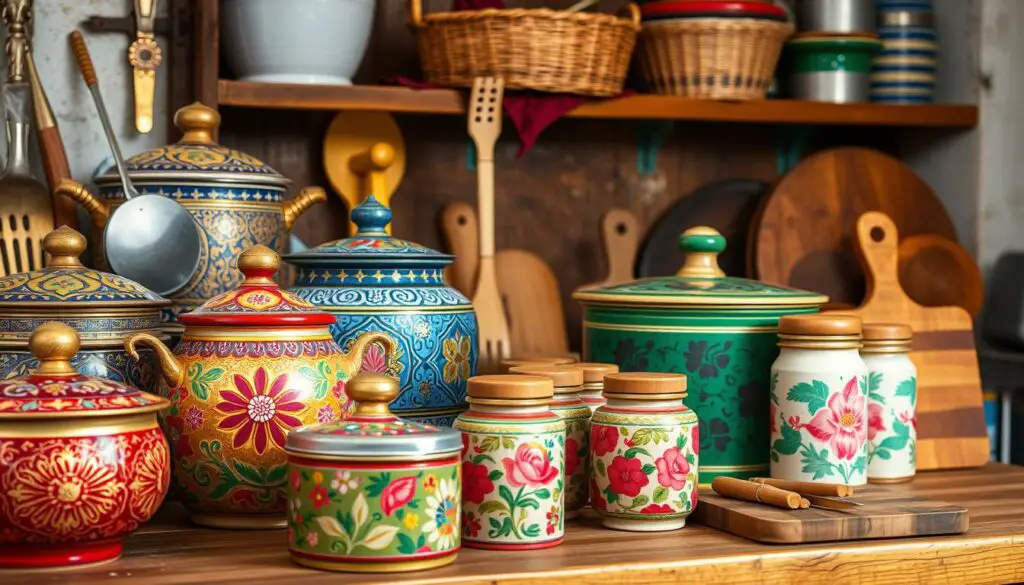
10. Adding a Touch of Nature
Adding natural elements makes Indian kitchens lively and fresh. Plants like money plants or snake plants clean the air and bring green into the space. They create a calm and refreshing vibe.
Herb gardens on windowsills or countertops offer fresh ingredients for cooking. They also make the kitchen look good, adding both function and beauty.
Indoor Plants for Freshness
Designers like Reflective Practices and Kreon Projects use wide window sills for kitchen gardens. This blends nature into the home’s core. These plants make the kitchen look better and are good for the environment.
Herb Gardens for Cooking and Decor
Herb gardens in Indian kitchens are both useful and stylish. They let homeowners easily get fragrant, tasty herbs. This not only improves cooking but also adds a unique, rustic charm to the kitchen’s design.
More Indian Kitchen Decor Ideas
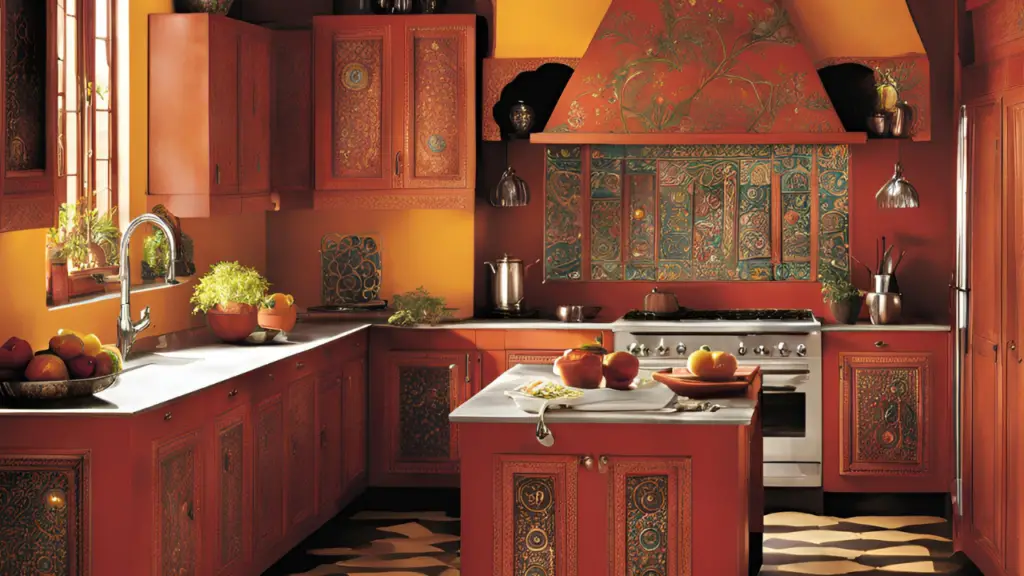
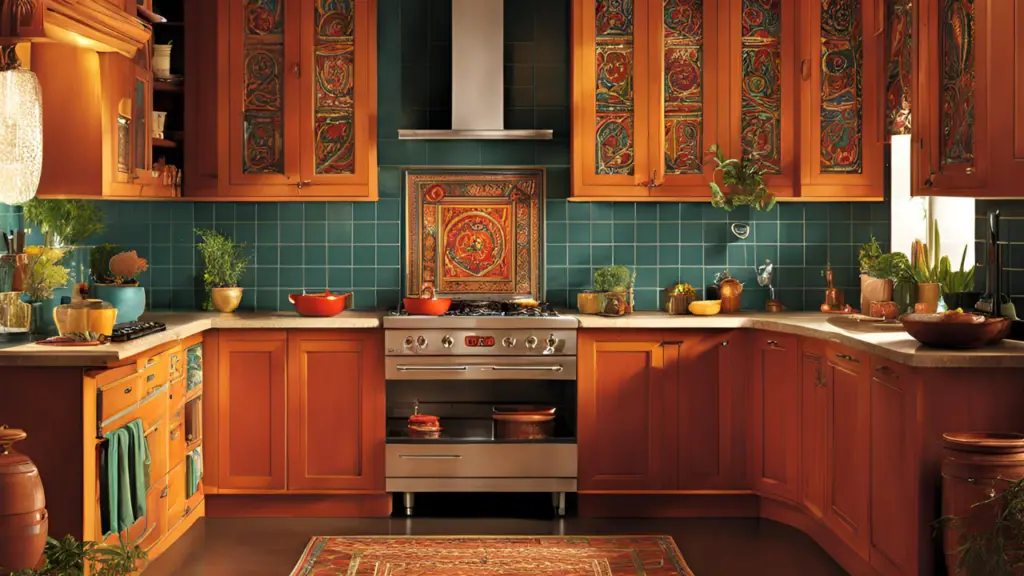
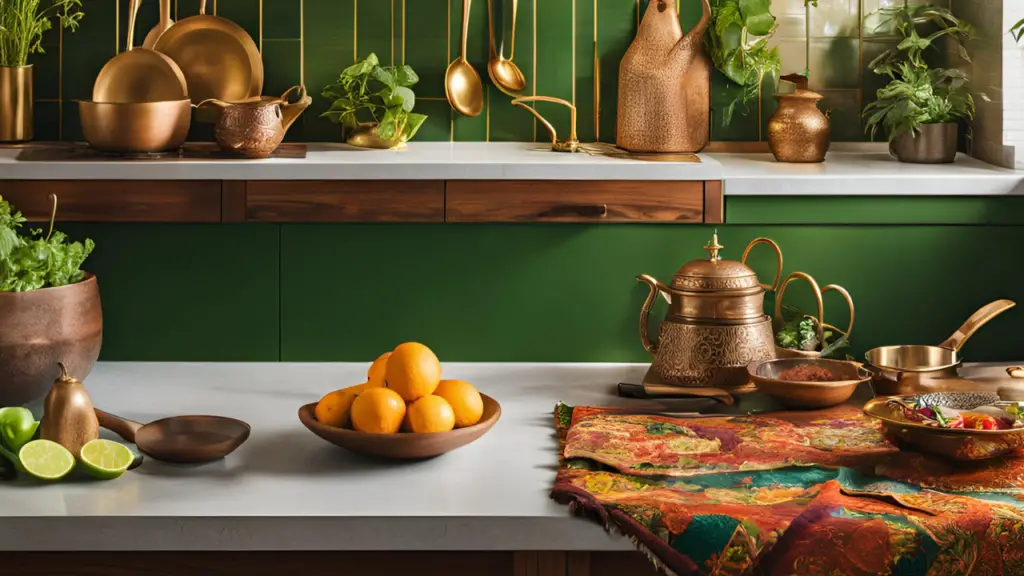
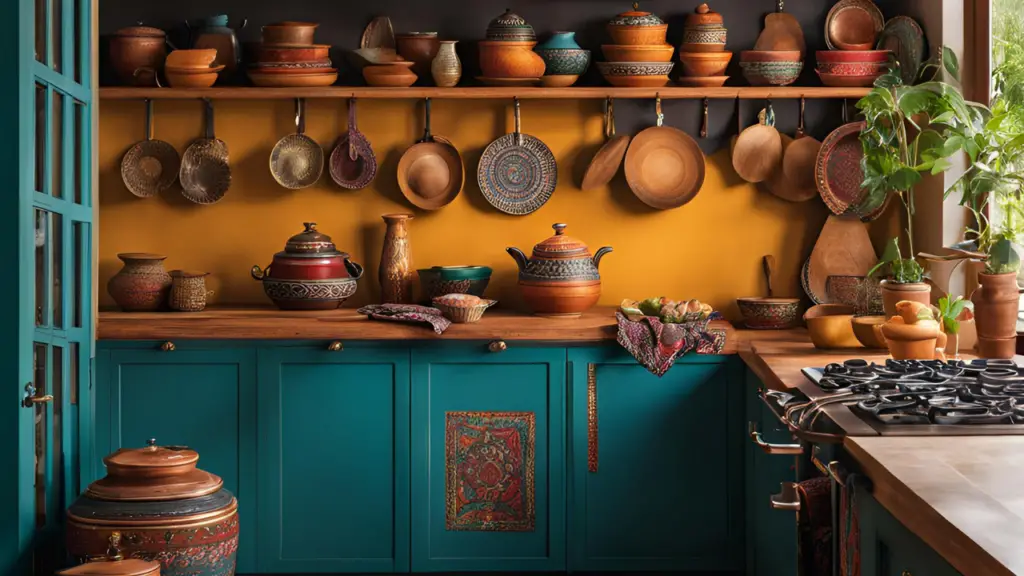
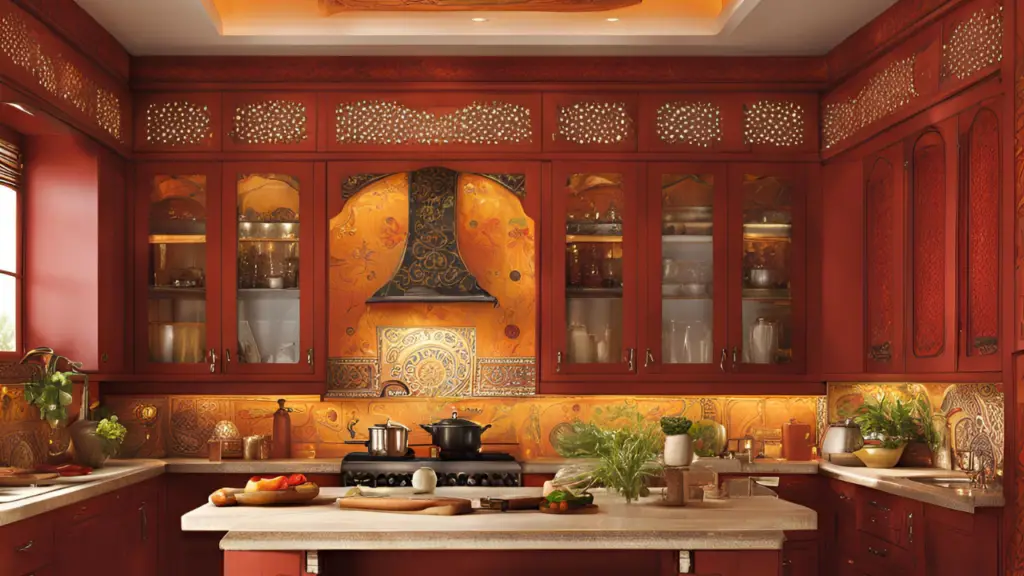
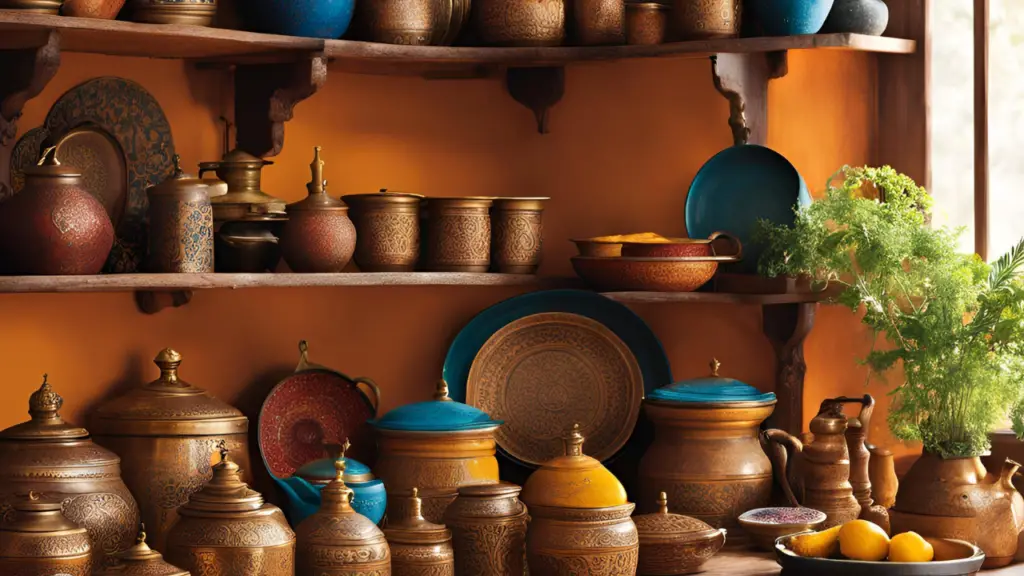
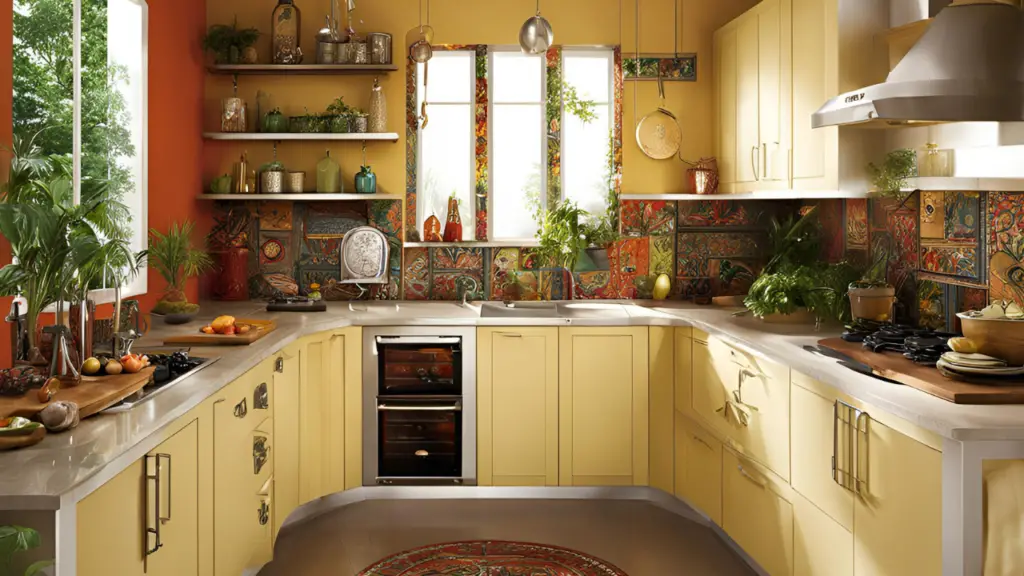
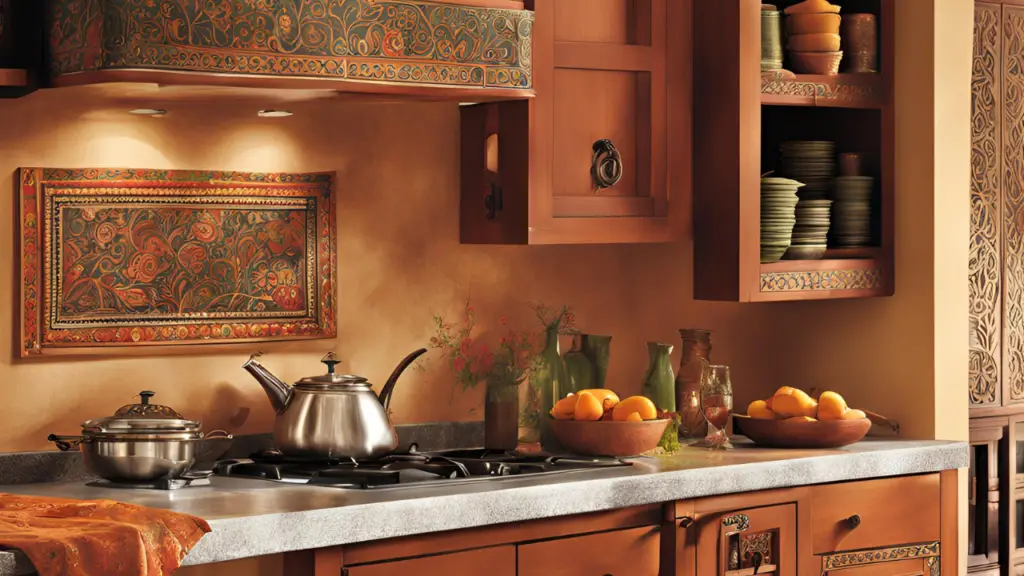
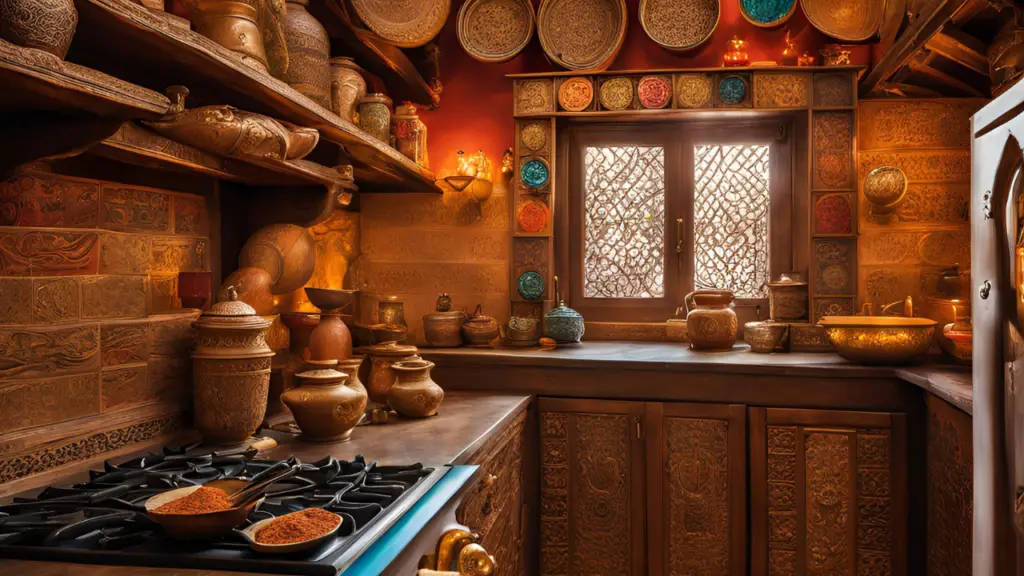
FAQ
What are some traditional Indian elements that can be incorporated into kitchen design?
Traditional Indian elements for kitchen design include handcrafted decor like pottery and woven baskets. Brass utensils and traditional textiles like block-printed curtains add charm. Cultural artwork, such as framed paintings or prints, also enhance the look.
What are the popular color palettes used in Indian kitchen design?
Indian kitchens often use vibrant colors inspired by spices and nature. Colors like turmeric yellow and saffron orange add warmth. Earthy tones like terracotta and mustard green create a cozy feel.
How can open shelving be used in Indian kitchens?
Open shelving is popular in Indian kitchens for its function and style. It’s great for displaying colorful spice jars and copper vessels. Adding small potted plants or vintage tools adds a personal touch.
What role does lighting play in Indian kitchen design?
Lighting is key in Indian kitchen design. Chandeliers and pendant lights add elegance. Glass-fronted cabinets with lighting showcase dishware and create ambiance. Natural light is maximized with windows and recessed lights.
How do modern Indian kitchens blend contemporary and traditional elements?
Modern Indian kitchens mix modern and traditional. They use sleek cabinets with wooden accents or tile work. This blend keeps cultural roots while adding modern touches.
How do Indian kitchens maximize space and functionality?
Indian kitchens focus on efficient space use. L-shaped layouts and island units with cooktops and storage save space. Modular storage and pull-out units make the most of every inch.
What role do cultural artworks play in Indian kitchen design?
Cultural artwork adds personality to Indian kitchens. Paintings or prints of Indian scenes or patterns are great for walls. Handcrafted pottery and sculptures on shelves or windowsills add cultural significance.
What materials are commonly used in Indian kitchen design?
Wood is popular for its warmth and versatility in Indian kitchens. Granite, quartz, or engineered stone countertops are durable and add beauty. Mixing materials creates texture and depth.
How do accessories contribute to Indian kitchen decor?
Accessories are key in Indian kitchen decor. Vibrant dining ware and traditional copper or brass utensils add color and flair. Decorative storage solutions like hand-painted jars or woven baskets are both practical and beautiful.
How can natural elements be incorporated into Indian kitchens?
Natural elements bring life to Indian kitchens. Indoor plants purify the air and add greenery. Herb gardens on windowsills or countertops provide fresh ingredients and enhance decor.

